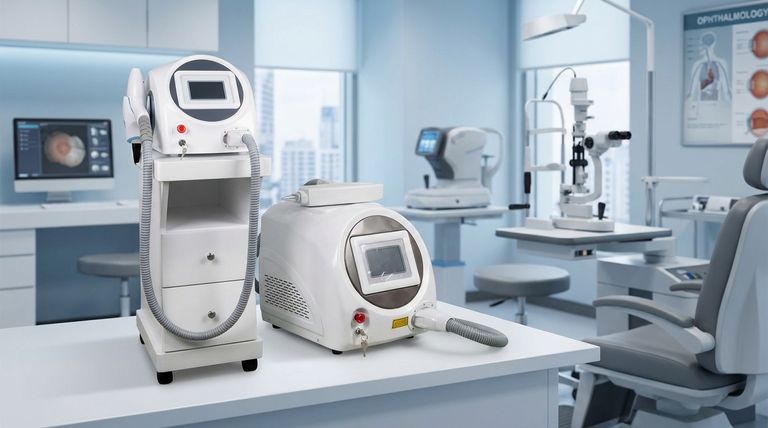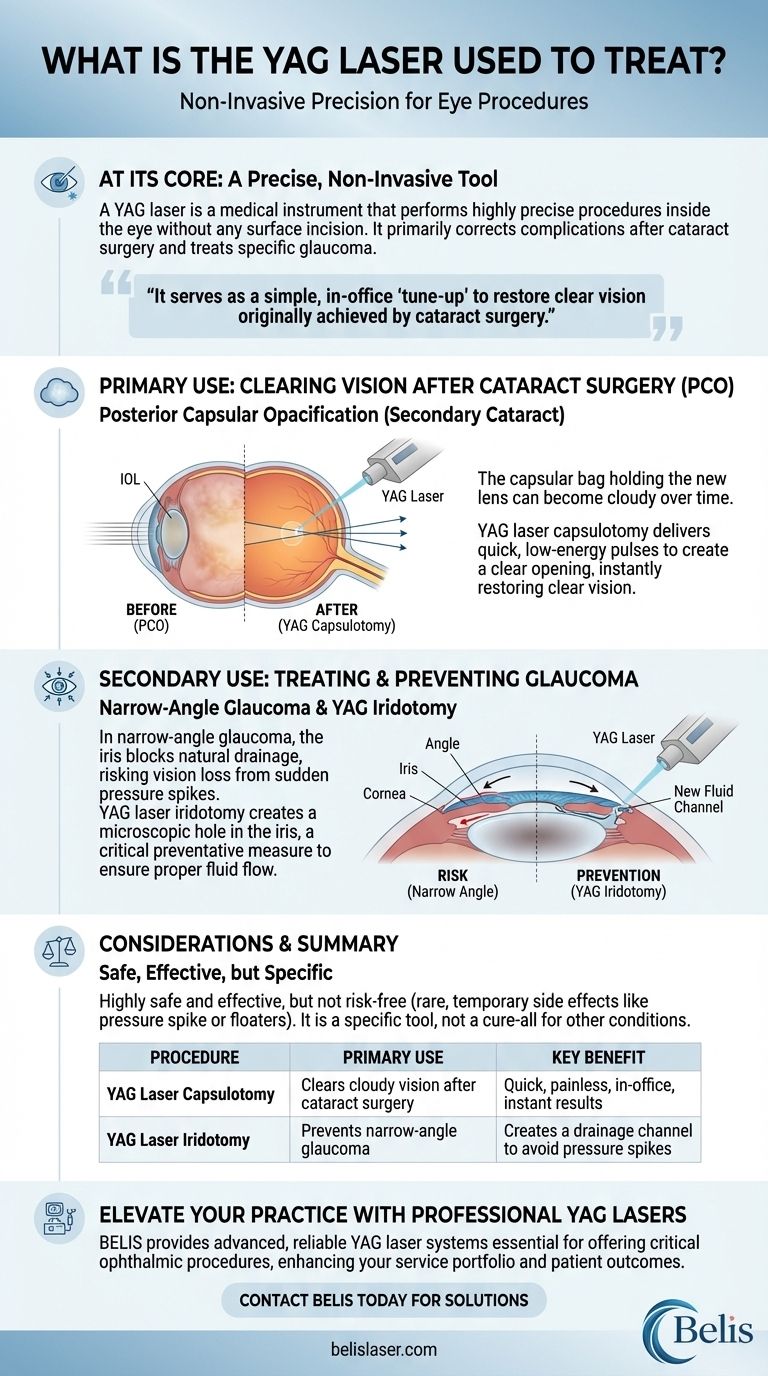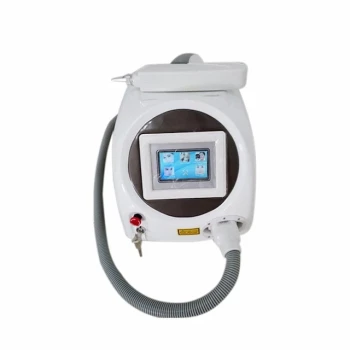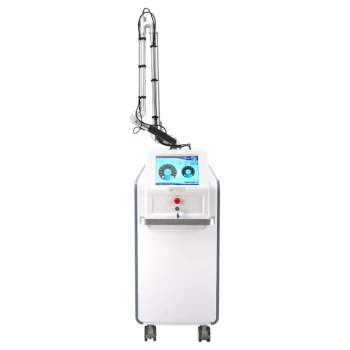At its core, a YAG laser is a non-invasive medical instrument used to perform highly precise procedures inside the eye. Its most common application is to correct a frequent complication that can arise after cataract surgery, but it is also a vital tool for treating a specific type of glaucoma. The laser allows an ophthalmologist to cut or create an opening in internal eye structures without making a single surgical incision on the eye's surface.
The YAG laser's primary function is not to remove the initial cataract, but to solve a predictable "secondary" clouding of vision that can occur months or years later. It serves as a simple, in-office "tune-up" to restore the clear vision originally achieved by cataract surgery.

The Primary Use: Clearing Vision After Cataract Surgery
The most frequent reason for a YAG laser procedure is to treat a condition called Posterior Capsular Opacification (PCO), often referred to as a "secondary cataract."
What is Posterior Capsular Opacification (PCO)?
During modern cataract surgery, your eye's natural, cloudy lens is removed. The thin, clear membrane that held that lens, known as the capsular bag, is left in place to hold the new artificial intraocular lens (IOL).
In many patients, this capsular bag can become hazy or frosted over time, causing blurred vision very similar to the original cataract. This is not the cataract returning; it is a predictable clouding of the membrane behind the new lens implant.
How the YAG Laser Solves the Problem
The procedure, called a YAG laser capsulotomy, is remarkably straightforward and effective.
The laser is aimed with extreme precision at the cloudy posterior capsule. It delivers quick, low-energy pulses to create a small, clear opening in the center of the membrane. This allows light to pass through unobstructed to the retina once again, instantly restoring clear vision.
The Patient Experience
A YAG capsulotomy is a quick, painless, and non-invasive outpatient procedure. It typically takes only a few minutes and is performed in the ophthalmologist's office, not an operating room. The eye is numbed with drops, and patients often notice an immediate improvement in their vision.
The Secondary Use: Treating Glaucoma
The YAG laser is also a critical tool for treating or preventing a specific form of glaucoma known as narrow-angle glaucoma.
Understanding Narrow-Angle Glaucoma
In some eyes, the space between the iris (the colored part of the eye) and the cornea (the clear front surface) is very narrow. The iris can bunch up and block the eye's natural drainage system, leading to a sudden and dangerous spike in eye pressure that can cause permanent vision loss.
How a YAG Laser Iridotomy Works
To prevent this, an ophthalmologist can perform a YAG laser iridotomy. The laser creates a microscopic hole in the outer edge of the iris.
This tiny opening creates a new channel for fluid to flow within the eye, preventing the pressure buildup that defines an angle-closure glaucoma attack. It is an essential preventative measure for at-risk individuals.
Understanding the Trade-offs and Considerations
While the YAG laser is exceptionally safe and effective, it is important to understand its specific role and limitations.
The Procedure is Not Risk-Free
Complications are very rare but can include a temporary spike in eye pressure immediately following the procedure, inflammation, or the appearance of new "floaters" in your vision. These issues are almost always minor and temporary.
It's a Highly Specific Tool
A YAG laser is not a cure-all. It does not treat the primary cataract, macular degeneration, or diabetic retinopathy. Its function is limited to creating precise openings in either the capsular bag or the iris.
Making the Right Choice for Your Goal
The decision to proceed with a YAG laser procedure is based on a clear diagnosis from your ophthalmologist.
- If your primary focus is restoring clarity after cataract surgery: A YAG capsulotomy is the standard, highly effective procedure to correct the blurry vision caused by a cloudy lens capsule.
- If your primary focus is preventing a glaucoma emergency: For those diagnosed with narrow angles, a YAG iridotomy is a critical, sight-saving procedure to ensure proper fluid flow within the eye.
Ultimately, understanding the precise role of the YAG laser empowers you to have a more informed discussion with your ophthalmologist about your long-term vision health.
Summary Table:
| Procedure | Primary Use | Key Benefit |
|---|---|---|
| YAG Laser Capsulotomy | Clears cloudy vision after cataract surgery | Quick, painless, in-office procedure; instant results |
| YAG Laser Iridotomy | Prevents narrow-angle glaucoma | Creates a drainage channel to avoid dangerous pressure spikes |
Elevate Your Practice with Professional YAG Lasers
BELIS specializes in providing advanced, reliable medical aesthetic equipment to medical aesthetics clinics and premium beauty salons. A professional YAG laser system is essential for offering critical ophthalmic procedures like capsulotomies and iridotomies, enhancing your service portfolio and patient outcomes.
Contact BELIS today to learn how our YAG laser solutions can drive your clinic's growth and deliver exceptional patient care.
Visual Guide

Related Products
- Q Switch Nd Yag Laser Machine Tattoo Removal Nd Yag Machine
- Clinic Use IPL and SHR Hair Removal Machine with Nd Yag Laser Tattoo Removal
- Pico Laser Tattoo Removal Machine Picosure Picosecond Laser Machine
- Pico Picosecond Laser Machine for Tattoo Removal Picosure Pico Laser
- Diode Laser SHR Trilaser Hair Removal Machine for Clinic Use
People Also Ask
- What are the disadvantages of Q-switch laser? Managing Risks for Safe Treatment
- Is Q Switched Nd:YAG laser good? The Gold Standard for Tattoo & Pigment Removal
- How does the Nd:YAG laser work? Unlocking Deep-Tissue Precision for Medical Aesthetics
- Is Q-Switch laser safe for skin? Achieve Precise, Non-Invasive Skin Rejuvenation Safely
- How much does a laser tattoo removal machine cost? Choose the Right Tech for Your Clinic



















